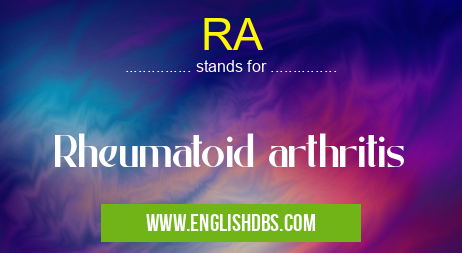What does RA mean in SYNDROMES
Rheumatoid arthritis (RA) is a chronic autoimmune disease that primarily affects the joints. It is characterized by inflammation, swelling, and pain in the joints, and can also lead to damage to the cartilage and bone.

RA meaning in Syndromes in Medical
RA mostly used in an acronym Syndromes in Category Medical that means Rheumatoid arthritis
Shorthand: RA,
Full Form: Rheumatoid arthritis
For more information of "Rheumatoid arthritis", see the section below.
RA Meaning in MEDICAL
RA stands for Rheumatoid Arthritis. It is a systemic inflammatory disease that affects the joints, causing pain, swelling, stiffness, and deformity. It can also affect other organs and tissues in the body, such as the skin, heart, lungs, and eyes.
RA Full Form
Rheumatoid Arthritis
What does RA Stand for?
RA stands for Rheumatoid Arthritis. It is a chronic inflammatory condition that affects the joints and other tissues in the body. It is an autoimmune disease, meaning that the immune system mistakenly attacks the body's own tissues.
Causes of RA
The exact cause of RA is unknown, but it is thought to be related to a combination of genetic and environmental factors. Some of the risk factors for RA include:
- Age: RA can occur at any age, but it is most common in people between the ages of 40 and 60.
- Sex: Women are more likely to develop RA than men.
- Family history: People with a family history of RA are more likely to develop the disease.
- Smoking: Smoking is a major risk factor for RA.
- Obesity: Obese people are more likely to develop RA.
- Certain infections: Some infections, such as Epstein-Barr virus and parvovirus B19, have been linked to an increased risk of RA.
Symptoms of RA
The symptoms of RA can vary from person to person. Some of the most common symptoms include:
- Joint pain: RA typically causes pain in the joints of the hands, wrists, feet, and knees.
- Swelling: The joints may also become swollen and red.
- Stiffness: RA can cause stiffness in the joints, especially in the morning.
- Fatigue: People with RA often experience fatigue.
- Weight loss: People with RA may lose weight unintentionally.
- Other symptoms: RA can also cause other symptoms, such as fever, chills, and muscle weakness.
Diagnosis of RA
RA can be diagnosed based on a physical examination and a review of the patient's symptoms. The doctor may also order blood tests and X-rays to help confirm the diagnosis.
Treatment of RA
There is no cure for RA, but there are treatments that can help to manage the symptoms and prevent joint damage. Some of the most common treatments for RA include:
- Medications: There are a variety of medications that can be used to treat RA, including nonsteroidal anti-inflammatory drugs (NSAIDs), disease-modifying antirheumatic drugs (DMARDs), and biologics.
- Physical therapy: Physical therapy can help to improve range of motion and reduce pain.
- Occupational therapy: Occupational therapy can help to teach patients how to perform everyday activities despite their arthritis.
- Surgery: Surgery may be necessary in some cases to repair damaged joints or relieve pain.
Essential Questions and Answers on Rheumatoid arthritis in "MEDICAL»SYNDROMES"
What is Rheumatoid Arthritis (RA)?
Rheumatoid arthritis (RA) is an autoimmune disease that causes inflammation in the joints. It can affect any joint in the body, but most commonly affects the joints in the hands, feet, and spine. RA can cause pain, swelling, stiffness, and deformity in the joints. It can also lead to fatigue, weight loss, and other systemic symptoms.
What causes RA?
The exact cause of RA is unknown. However, it is thought that the immune system, which normally protects the body from infection, mistakenly attacks the joints. This leads to inflammation and damage to the joints.
Who is at risk for RA?
RA can affect anyone, but it is more common in women than in men. It typically develops between the ages of 40 and 60. People who have a family history of RA are at increased risk for developing the disease.
What are the symptoms of RA?
The symptoms of RA can vary depending on the severity of the disease. Common symptoms include:
- Pain, swelling, and stiffness in the joints
- Fatigue
- Weight loss
- Loss of appetite
- Fever
- Muscle aches
- Joint deformity
How is RA diagnosed?
RA is diagnosed based on a physical examination, medical history, and blood tests. There is no single test that can definitively diagnose RA. However, there are a number of blood tests that can help to identify the presence of inflammation and the presence of certain antibodies that are associated with RA.
How is RA treated?
There is no cure for RA, but there are a number of treatments that can help to manage the symptoms of the disease. These treatments include:
- Medications to reduce inflammation and pain
- Physical therapy to improve range of motion and function
- Occupational therapy to help with activities of daily living
- Surgery to repair or replace damaged joints
Final Words: RA is a chronic autoimmune disease that can cause pain, swelling, and damage to the joints. There is no cure for RA, but there are treatments that can help to manage the symptoms and prevent joint damage. If you think you may have RA, it is important to see your doctor for a diagnosis and treatment.
RA also stands for: |
|
| All stands for RA |
